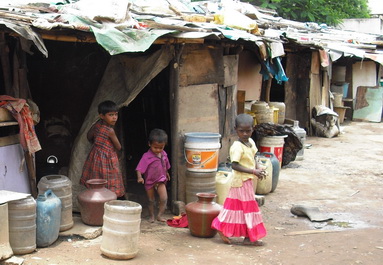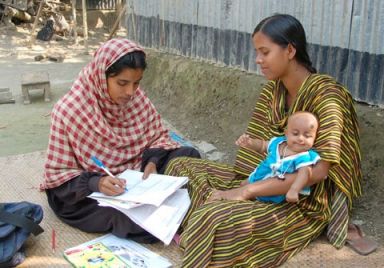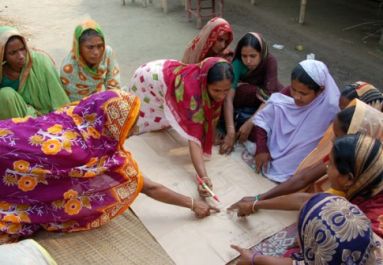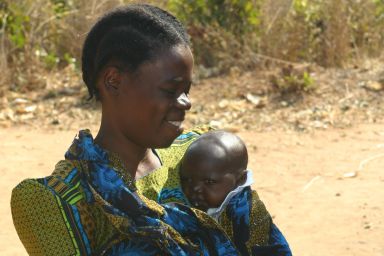
Research
Aims
EquiNaM aims to build evidence to support an equitable improvement in newborn and maternal health. In particular, it will generate evidence on:
- the magnitude of socio-economic inequalities in newborn and maternal mortality;
- how socio-economic inequalities translate into inequalities in newborn and maternal mortality within countries;
- how to address the exclusion of poor and otherwise marginalised groups from efforts to achieve the MDGs;
- how to reduce socio-economic inequalities in newborn and maternal and newborn mortality.
Background
Progress towards the MDGs has been highly uneven. In particular, inequalities in maternal and child health and health care are huge. Few of the poorest women in developing countries, for example, receive professional care during delivery, while the majority of their richer compatriots do. The link between socio-economic disadvantage and health disadvantage has enormous consequences: one third of global childhood deaths, for instance, are attributable to socio-economic mortality inequalities within countries. To make things worse, effective interventions are known, but rarely reach those who need them most.
 Unfortunately, there is a paucity of evidence about inequality in the health outcomes that show least progress: newborn and maternal mortality. While newborn mortality has become increasingly important in terms of its relative contribution to under-5 mortality and to reaching MDG4, policy and research attention on the newborn period has lagged behind. Furthermore, little is known about what works to effectively reach poor and otherwise disadvantaged groups, and how to address socio-economic inequalities in health. Supporting equitable achievement of the MDGs, and reducing socio-economic inequalities in maternal and newborn mortality, requires building evidence on:
Unfortunately, there is a paucity of evidence about inequality in the health outcomes that show least progress: newborn and maternal mortality. While newborn mortality has become increasingly important in terms of its relative contribution to under-5 mortality and to reaching MDG4, policy and research attention on the newborn period has lagged behind. Furthermore, little is known about what works to effectively reach poor and otherwise disadvantaged groups, and how to address socio-economic inequalities in health. Supporting equitable achievement of the MDGs, and reducing socio-economic inequalities in maternal and newborn mortality, requires building evidence on:
- the magnitude of socio-economic inequalities in newborn and matneral mortality,
- what explains these inequalities,
- how to reach poor and otherwise marginalised groups with effective interventions, and
- what works to reduce mortality inequalities.
By using data from large demographic surveillance sites and randomised controlled trials, our project provides detailed evidence on the magnitude and determinants of socio-economic inequalities in maternal and newborn mortality in Asia and Africa, and contributes to the evidence base on what works to reduce them.
Surveillance data
EquiNam builds on a global network of demographic surveillance sites that provides some of the largest population-bases of prospectively collected data for maternal and newborn mortality studies in low and middle income countries. We use data from six sites, in India (Mumbai and Orissa & Jharkhand), rural Nepal (Dhanusha, and Makwanpur districts), rural Bangladesh and rural Malawi, with a combined population of over 2 million.
 All women of reproductive age at the sites are prospectively followed up on an ongoing basis (see surveillance system overview). Local key informants, typically covering a geographic area of 200-250 households, identify all births and deaths to women of reproductive age.
All women of reproductive age at the sites are prospectively followed up on an ongoing basis (see surveillance system overview). Local key informants, typically covering a geographic area of 200-250 households, identify all births and deaths to women of reproductive age.
Full-time salaried interviewers are used to verify the information of the key informants and to interview all mothers six weeks post-partum to collect data on birth outcomes, socio-economic background, home care practices, morbidity and care seeking during pregnancy, delivery and the postnatal period. In the event of a stillbirth, neonatal death or maternal death, a verbal autopsy is done. Comparable data are collected across the sites, complemented by information relevant to specific contexts.
The system has been extensively tested and used in randomized controlled trials over the past ten years, and has been found to produce reliable mortality data. Data from six different contexts allows us to explore important sources of heterogeneity in effect between sites; for example, in home care practices, access to health care and community interventions.
Randomised controlled trials
 The surveillance sites were set up to evaluate the impact of community mobilisation interventions on neonatal mortality. The intervention consists of women’s groups, facilitated by a local woman, that meet monthly. The facilitator leads the groups through a participatory action cycle, in which they identify and prioritise maternal and newborn health problems in the community, collectively select relevant strategies to address them, implement the strategies, and evaluate the results.
The surveillance sites were set up to evaluate the impact of community mobilisation interventions on neonatal mortality. The intervention consists of women’s groups, facilitated by a local woman, that meet monthly. The facilitator leads the groups through a participatory action cycle, in which they identify and prioritise maternal and newborn health problems in the community, collectively select relevant strategies to address them, implement the strategies, and evaluate the results.
Groups use methods such as picture card games, role-play, and storytelling to facilitate discussions on the causes and effects of typical problems among mothers and babies, and devise strategies for prevention, supporting health care and safe home care.
The women’s groups were evaluated using a cluster RCT design, in which communities were randomly allocated to intervention or control groups. The hallmark trial was conducted in Makwanpur, Nepal, and suggested that community mobilisation through women's groups could substantially reduce mortality. This was followed by trials in Orissa and Jharkhand and in Bangladesh and four further trials are nearing completion.
Analyses
Our analyses are done in four phases:
- Phase A: Programme Incidence. Programme-incidence analysis, following Gwatkin (2003) determines “the distribution of programme outputs across socio-economic groups within the population that the programmes serve”. Using surveillance data from the intervention areas, we will examine attendance at the women’s groups among lower and higher socio-economic groups.
- Phase B: Equity Impact. We will re-analyse the randomized controlled trials of participatory women’s group interventions in India, Nepal, Bangladesh and Malawi to evaluate the equity impact of community mobilization, in particular with respect to neonatal mortality.
- Phase C: Description of mortality inequalities. We will describe socio-economic inequalities in newborn and maternal mortality using surveillance system data.
- Phase D: Explanation of mortality inequalities. We will examine the contribution of home care practices and health care use to socio-economic inequalities in newborn and maternal mortality.
We combine quantitative data from the surveillance systems and randomized trials with qualitative data that will be specifically collected for the project. The qualitative data will help interpret our quantitative findings.